Is your elegant Norwegian Forest Cat turning your cozy home into a hairball battlefield? Managing hairballs in Norwegian Forest Cats is a common yet daunting task many pet owners face. Understanding how to handle Norwegian Forest Cat hairballs is crucial for the health and comfort of your feline friend.
If you’ve ever found yourself puzzled over the persistent hairball issues with your long-haired companion, you’re not alone. In this guide, you’ll discover why these captivating cats are prone to hairballs and uncover practical Norwegian Forest Cat hairball prevention strategies that can make life easier for both you and your cat.
Key Takeaways
- Understanding the unique hairball challenges of Norwegian Forest Cats.
- Practical tips on how to handle Norwegian Forest Cat hairballs.
- Effective hairball prevention techniques tailored for this breed.
- Insights into managing hairballs to enhance your cat’s well-being.
- Proactive steps to create a hairball-free home environment.
The Basics of Norwegian Forest Cat Hairballs
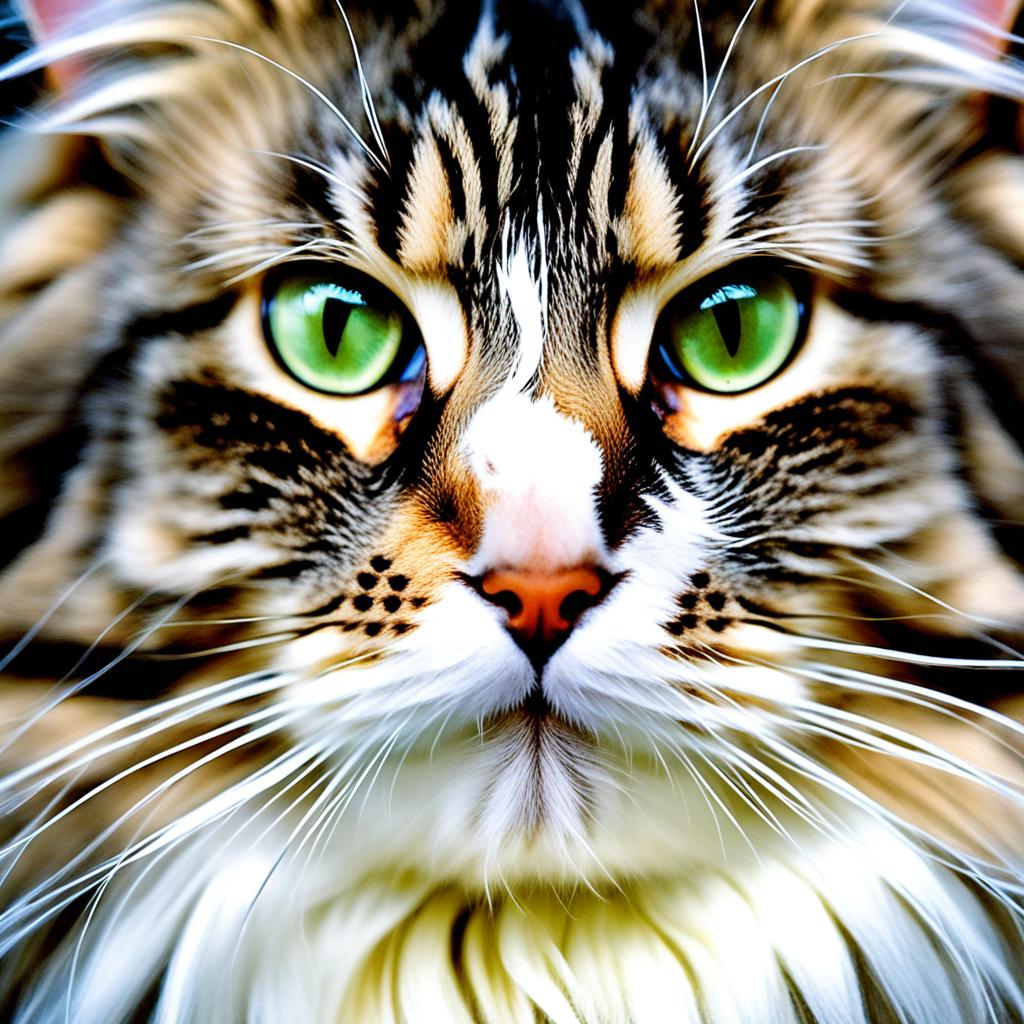
Norwegian Forest Cats are known for their luxurious, dense fur which, while beautiful, can contribute to the common issue of hairball formation. Understanding hairballs in these majestic cats is paramount in keeping them healthy and comfortable.
Understanding Hairball Formation
Hairball formation in cats occurs when they groom themselves and ingest loose fur. This fur travels down their digestive tract, where it sometimes forms a clump, leading to a hairball. Norwegian Forest Cats, with their long coats, are particularly prone to this issue. As meticulous groomers, they tend to ingest more fur, increasing the likelihood of hairball formation.
Signs Your Cat Is Struggling with Hairballs
Identifying the symptoms of cat hairballs is crucial for any cat owner. Common signs include frequent coughing, gagging, and retching without producing a hairball. You might also observe a reduction in appetite, constipation, and lethargy in your furry friend. These symptoms signal that your cat might be having difficulty passing the ingested fur naturally.
Why Norwegian Forest Cats Are Prone to Hairballs
Certain hairball-prone cat breeds, like the Norwegian Forest Cat, are more susceptible due to their unique fur characteristics. The dense, water-repellent coat of these cats requires meticulous self-grooming, leading to the ingestion of more hair compared to shorter-haired breeds. Their thick fur also has the propensity to shed seasonally, adding to the hairball risk. Thus, regular grooming and monitoring are essential to mitigate the problem.
Prevention of Hairballs in Norwegian Forest Cats
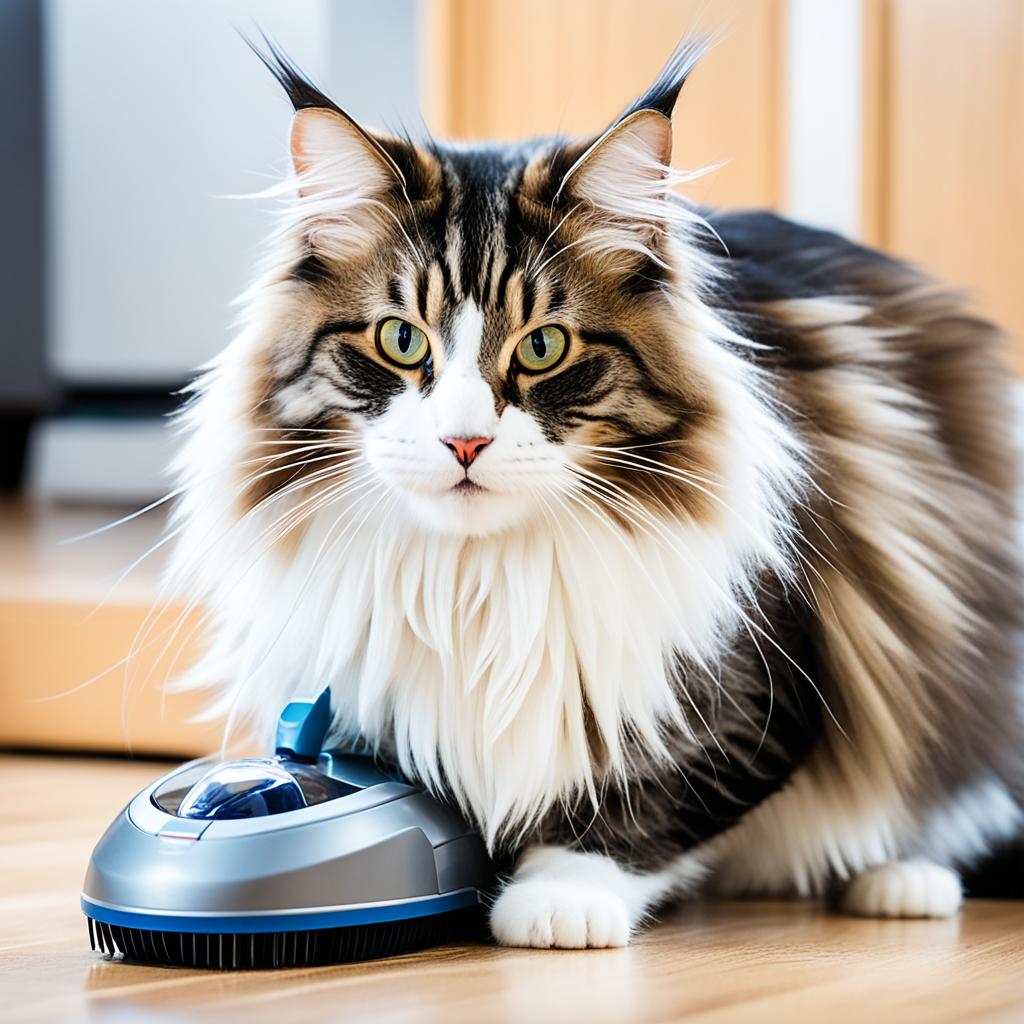
When it comes to the prevention of Norwegian Forest Cat hairballs, a proactive approach is key. These majestic felines, with their lush, thick fur, can often fall prey to pesky hairball issues. But fret not – implementing effective hairball prevention strategies will keep your furry friend comfortable and hairball-free.
First and foremost, regular grooming is paramount. Brushing your cat’s coat daily helps to remove loose hair before it gets ingested. This simple habit can significantly reduce the frequency of hairball incidents. Use a high-quality brush designed for long-haired breeds to ensure that grooming sessions are both effective and enjoyable for your cat.
Dietary changes also play a crucial role in the prevention of Norwegian Forest Cat hairballs. Look for cat foods that are specifically formulated to prevent hairballs. These products often contain added fiber, which aids in the passage of hair through your cat’s digestive system. Consult with your veterinarian to select the best diet tailored to your cat’s needs.
- Groom your cat daily to remove loose fur.
- Provide your cat with a hairball control diet.
- Ensure your cat stays hydrated to support digestive health.
Another vital aspect to consider is hydration. Ensure that your cat always has access to fresh water. Proper hydration helps maintain a healthy digestive system, making it easier for your cat to pass any ingested hair.
| Prevention Strategies | Benefits |
|---|---|
| Daily Grooming | Reduces loose fur and prevents ingested hair |
| Hairball Control Diet | Promotes fiber intake and aids digestion |
| Adequate Hydration | Supports a healthy gut and easier hair passage |
| Regular Vet Check-Ups | Helps identify and address potential issues early |
Lastly, schedule regular veterinary check-ups. These visits allow your vet to monitor your cat’s overall health and address any underlying issues that might contribute to hairball formation. With these combined hairball prevention strategies, you can ensure a comfortable and happy life for your Norwegian Forest Cat.
Best Practices for Hairball Control in Norwegian Forest Cats
To tackle hairballs in your Norwegian Forest Cat effectively, integrating best practices for hairball control is crucial. It’s not merely about addressing the issue but maintaining their overall well-being. Here are some comprehensive methods to ensure effective hairball management:
Brushing Routine: Establishing a regular brushing routine is essential. Norwegian Forest Cats have long, dense fur that requires frequent grooming. Using brushes specifically designed for long-haired cats can significantly reduce the amount of loose hair your cat ingests, thus aiding in effective hairball management.
Hairball Control Cat Food: Feeding your cat specially formulated hairball control food can help manage and prevent hairballs. These types of cat food typically contain a blend of fiber and other ingredients that aid in the natural elimination of ingested hair.
Hydration Tips: Ensuring your Norwegian Forest Cat stays hydrated is another vital practice. Adequate water intake helps their digestive system function correctly, allowing hair to pass through more easily. You could use water fountains or wet cat food to encourage hydration.
- Dietary Changes: Introduce high-fiber foods and treats that help cleanse the digestive tract, easing hairball elimination.
- Playtime and Exercise: Regular play and exercise help with digestion and reduce stress, which can indirectly decrease hairball problems.
- Regular Veterinary Check-ups: Frequent check-ups allow your vet to monitor your cat’s health, providing professional advice on effective hairball management.
Implement these best practices for hairball control in Norwegian Forest Cats to keep your feline friend healthy and comfortable.
How to Handle Norwegian Forest Cat Hairballs?
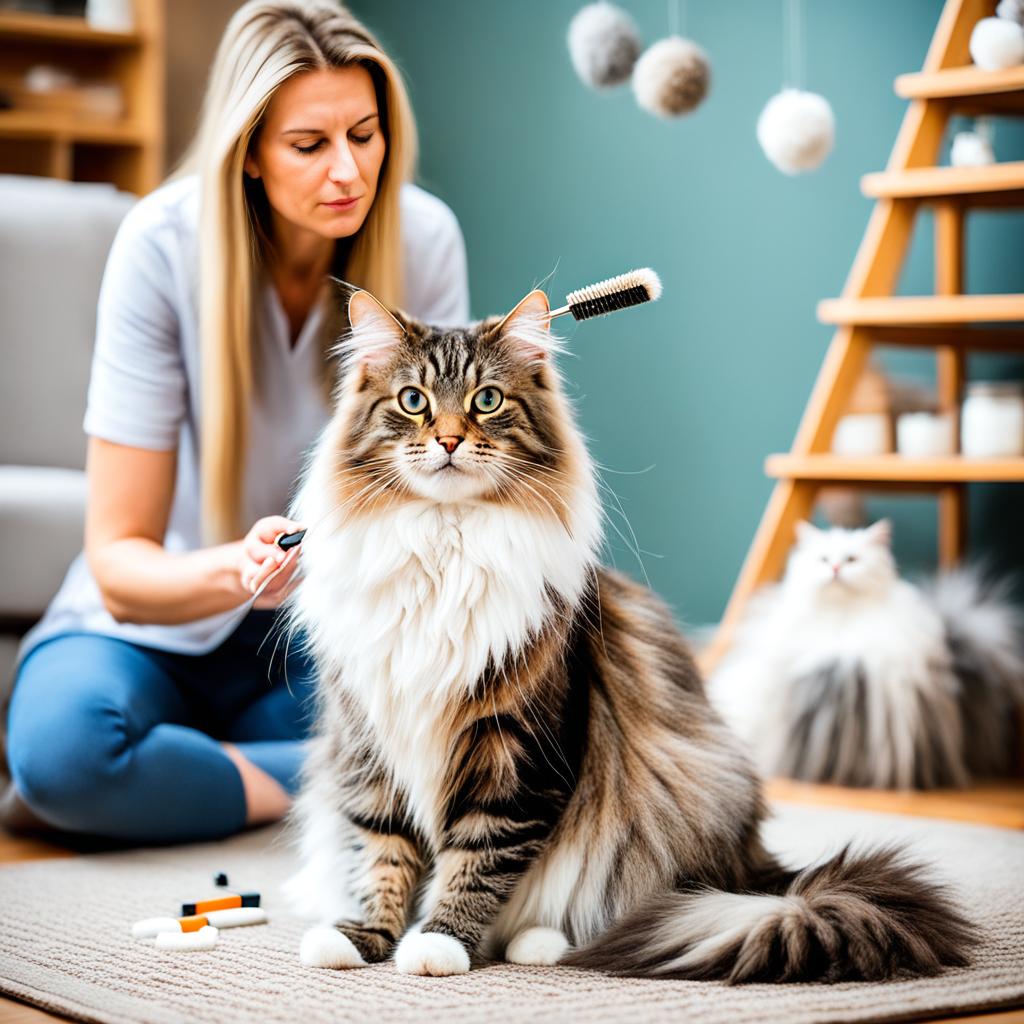
When dealing with the annoyance of hairballs in your cherished Norwegian Forest Cat, the right approach can make a world of difference. Let’s dive into practical methods that address both immediate and long-term remedies.
Immediate Solutions for Hairball Ingestion
Immediate hairball solutions are essential for providing fast relief to your feline friend. One effective method is using hairball paste, which lubricates the digestive tract, making it easier for the hairball to pass. These pastes are typically available at pet stores and veterinarians. Another quick fix involves ensuring your cat is well-hydrated. Water aids in the smoother passage of hairballs through the digestive system.
For more stubborn cases, a gentle massage of your cat’s abdomen could stimulate movement. If your cat is willing, increasing their activity level with interactive play could also help dislodge the hairball.
Dietary Adjustments for Hairball Reduction
Long-term management is just as crucial, and dietary changes for hairballs can significantly reduce their occurrence. High-fiber diets are particularly beneficial as they help in binding loose fur, pushing it through the digestive tract efficiently. Consider incorporating specialized hairball control cat food in your cat’s meals. These foods are formulated to support your cat’s digestive health while minimizing hairball formation.
Another proactive step includes regular inclusion of wet food in your cat’s diet. The extra moisture content aids digestion, reducing hairball episodes. Discussing dietary adjustments for hairballs with your vet can provide tailored recommendations that suit your cat’s specific needs.
By combining immediate hairball solutions with thoughtful dietary changes, you can keep your Norwegian Forest Cat happy and hairball-free.
Norwegian Forest Cat Hairball Remedies
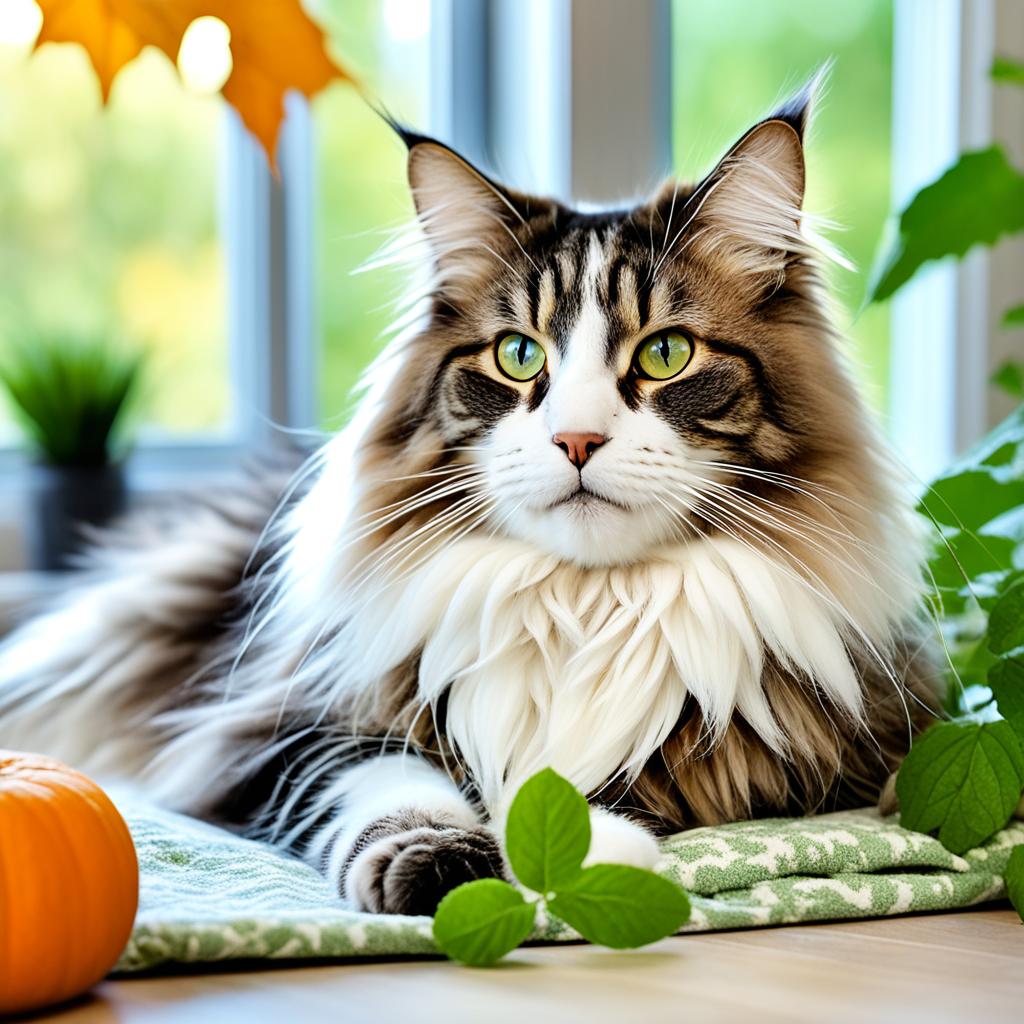
If you’re searching for effective Norwegian Forest Cat hairball remedies, you’ve landed in the right place. Whether you’re considering commercial solutions or exploring the realm of home remedies, there are multiple options available to provide relief for your feline friend.
Over-the-Counter Treatments
Over-the-counter hairball relief products can quickly become your go-to solution. These products, available in various formats like gels, tablets, and treats, often contain lubricating agents such as petroleum or mineral oil that help move hairballs through your cat’s digestive tract. Popular choices include brands like Laxatone and Sentry Hairball Relief. Always ensure you follow the recommended dosages to keep your cat in optimal health.
Home Remedies for Hairballs
If you prefer natural hairball remedies, several options are easily available. A teaspoon of olive oil added to your cat’s food can help lubricate their digestive system. Pumpkin puree, rich in fiber, is another effective solution to assist with smoother hairball passage. Regular use of these natural ingredients can be a gentle and wholesome way to mitigate hairball issues.
Minimizing Hairballs in Norwegian Forest Cats

Norwegian Forest Cats, with their luxurious coats, are undoubtedly gorgeous. However, their abundant fur means they are prone to developing hairballs. Fortunately, you can take several steps to minimize hairballs in your beloved feline friend. Not only will this help in reducing hairball frequency, but it will also enhance their overall health and well-being.
For every whisker they shed, Norwegian Forest Cats gather some in their stomach—it’s just the nature of the beast.
Regular grooming is your first line of defense. By engaging in frequent grooming sessions, you can remove loose fur before your cat ingests it. Implementing a brisk brushing session multiple times a week should do the trick. Additionally, consider professional grooming services during the shedding seasons for a thorough job.
- Reduce stress in your cat’s environment. Stress can exacerbate fur shedding, leading to more hairballs. Create a tranquil and enriching habitat with interactive toys and cozy resting spots.
- Environmental enrichment helps keep your cat active, thus reducing hairball formation. Invest in climbing trees and puzzle feeders to keep your cat’s mind and body engaged.
Including high-quality and specially formulated cat food can also assist in minimizing hairballs in Norwegian Forest Cats. These diets are generally rich in fiber, which helps move ingested hair through the digestive system more efficiently. Consult your vet to find the most apt dietary choice for reducing hairball frequency.
By incorporating these techniques, you’ll be well on your way to creating a happier, hairball-free environment for your Norwegian Forest Cat, resulting in less cleaning up and a healthier pet. The effort you put in now will pay off in fewer visits to the vet and a more comfortable life for your feline friend.
Tips for Dealing with Norwegian Forest Cat Hairballs
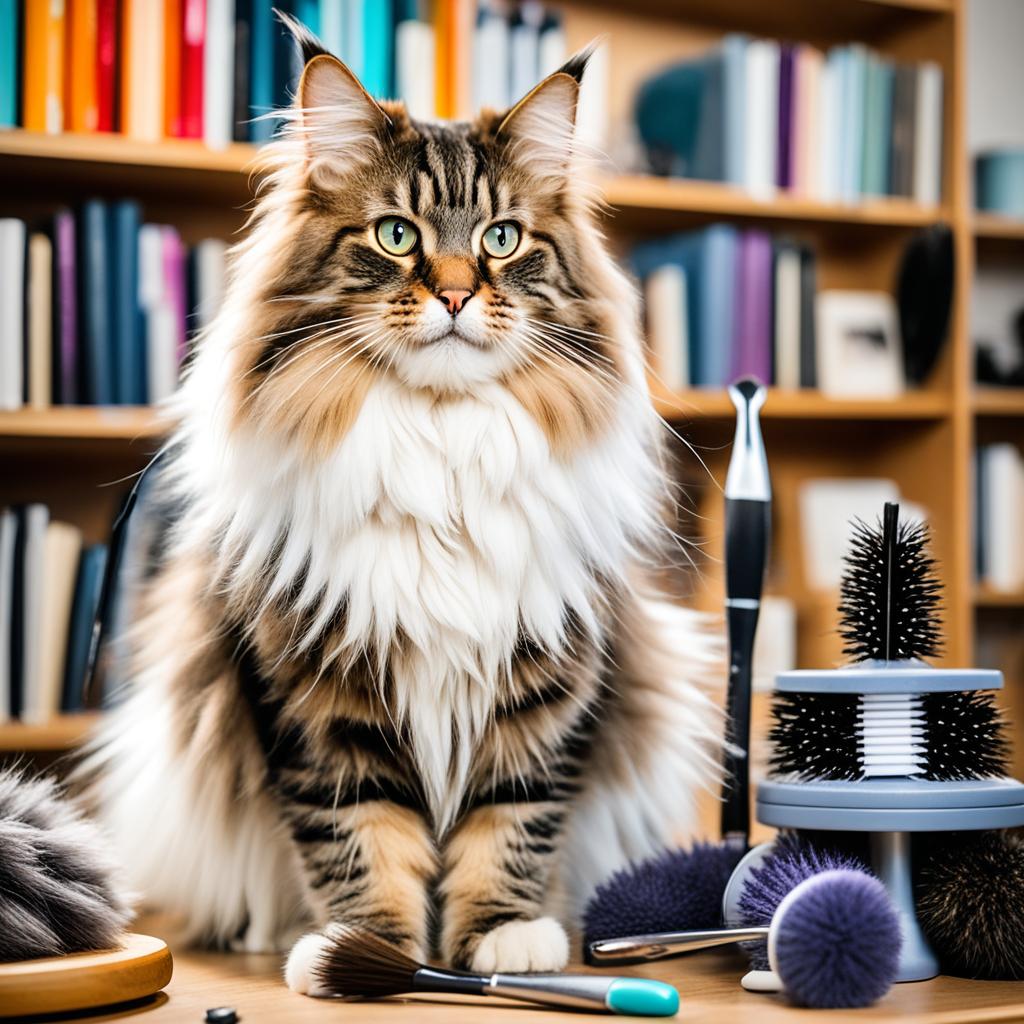
When it comes to coping with hairballs in Norwegian Forest Cats, a few smart strategies can make a world of difference. Below are some actionable tips to help you manage this furry dilemma with ease.
Cleaning Up Hairballs
Let’s start with the messy part. If your cat has just gifted you with a hairball, the best way to clean it up is to let it dry slightly for easier removal. Use an enzymatic cleaner to eliminate any lingering odors and prevent re-soiling. Keep a stack of paper towels handy for quick cleanups.
Preventive Grooming
Norwegian Forest Cats have luxurious, thick coats that require regular grooming to minimize hairball formation. A daily brushing routine can go a long way in reducing the amount of loose fur that your cat ingests. Opt for a slicker brush or a grooming glove to make the process more comfortable for your feline friend.
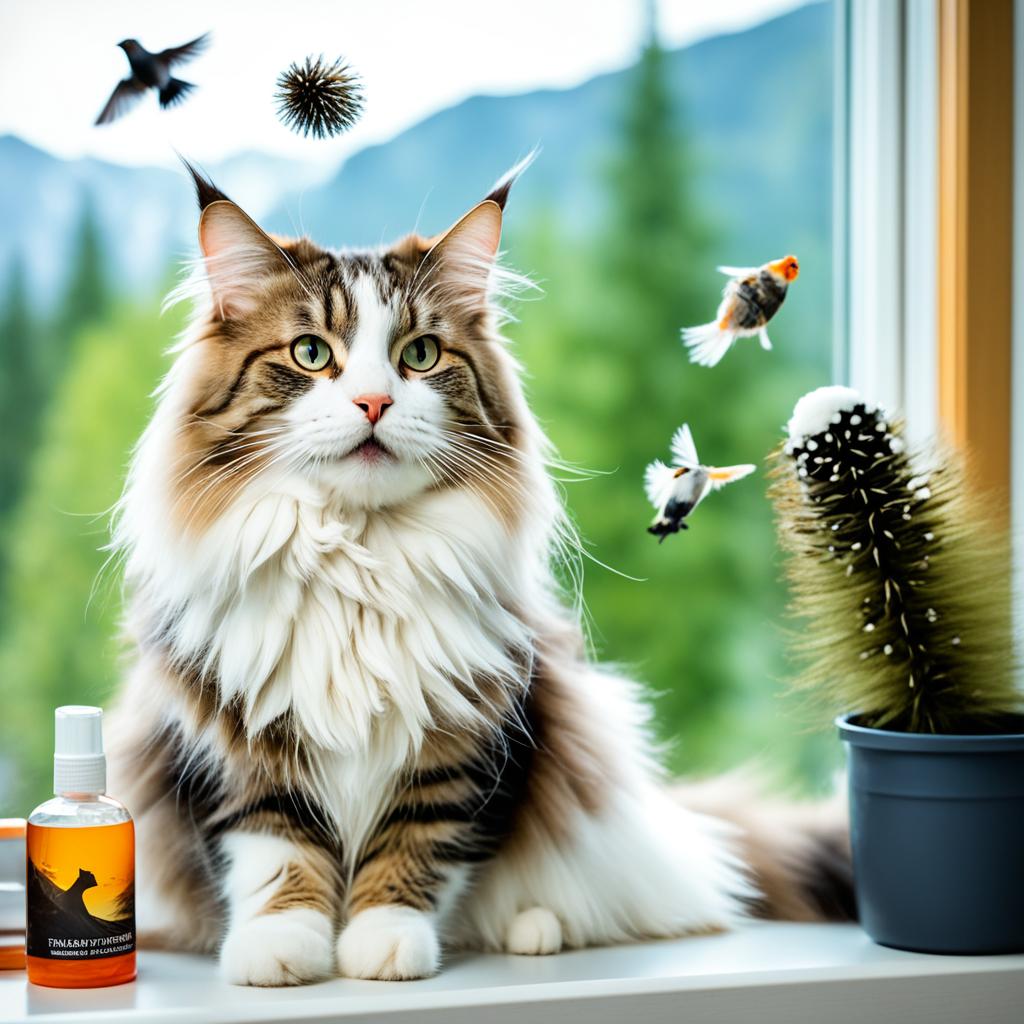
- Watch for Complications: Monitor your cat for signs of distress or frequent gagging, as these can be indications of complications requiring veterinary attention.
- Stay Hydrated: Make sure your kitty always has access to fresh water. Proper hydration assists in smooth digestion and reduces hairball formation.
- Use Hairball Remedies: Consider over-the-counter hairball remedies such as gels or pastes designed to lubricate your cat’s digestive tract.
Dietary Adjustments
Feeding your Norwegian Forest Cat a diet specifically formulated to reduce hairballs is another effective strategy. High-fiber cat foods can help move ingested fur through the digestive system more efficiently, thereby reducing the likelihood of hairball formation.
| Tip | Details |
|---|---|
| Brushing Frequency | Daily |
| Special Diet | High-Fiber Food |
| Hydration | Unlimited Fresh Water |
| Hairball Remedies | OTC Gels & Pastes |
| Veterinary Check-Ups | Regularly |
When coping with hairballs in Norwegian Forest Cats, always stay proactive. Implement these tips consistently to keep both you and your feline fur-free and happy!
Managing Hairballs in Norwegian Forest Cats
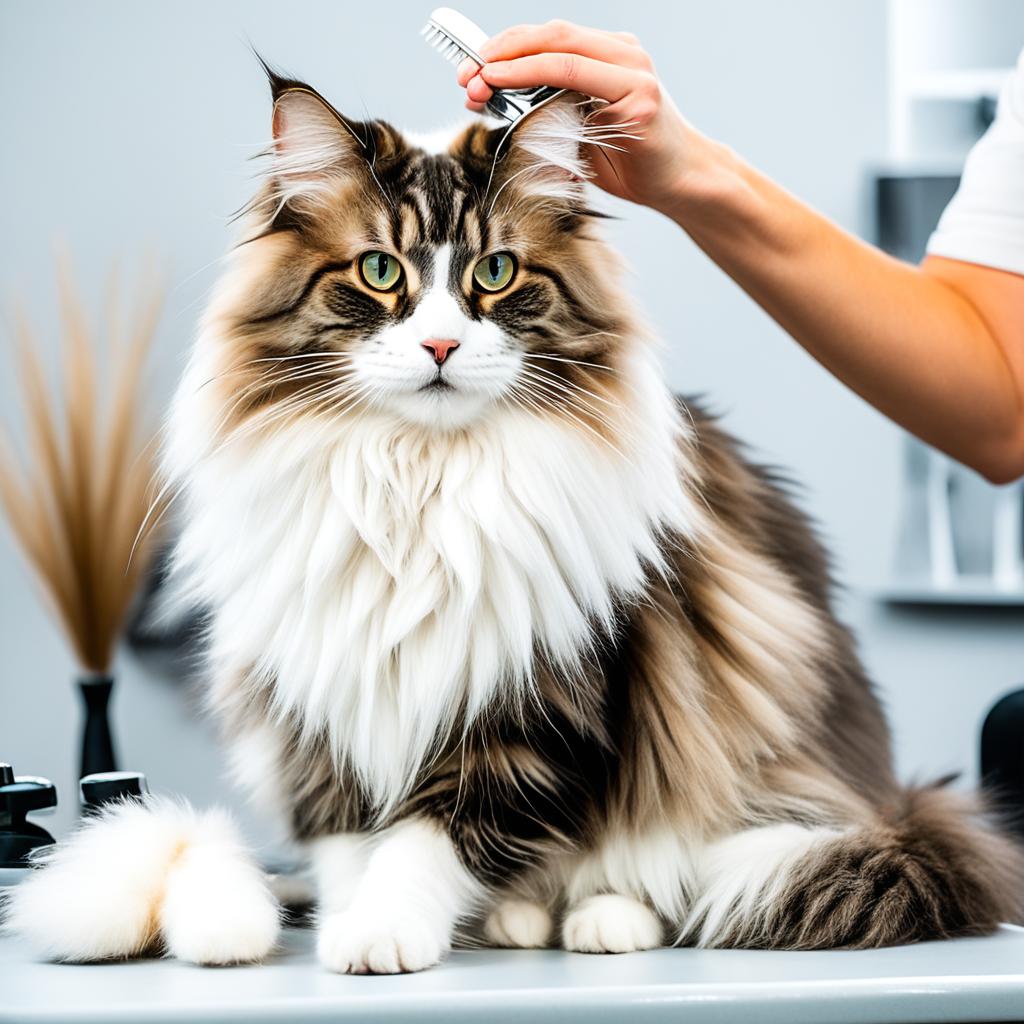
Managing hairballs in your Norwegian Forest Cat requires a diligent approach to grooming and the use of targeted products. Tackling this issue not only ensures the well-being of your pet but also reduces the dreaded clean-up duty. Understanding how to integrate grooming and hairball prevention products effectively into your routine is key.
Regular Grooming Techniques
Regular grooming for hairball management begins with choosing the right tools. A high-quality brush can work wonders by removing loose fur before it can be ingested. Aim to brush your Norwegian Forest Cat at least a few times a week.
- Use a slicker brush to detangle mats and remove dead hair.
- Follow up with a metal comb to reach the undercoat and ensure thorough grooming.
- Try grooming gloves for a gentle massage that also aids in fur removal.
Setting a regular grooming schedule and making it a bonding activity can make this process enjoyable for both you and your cat. Not only does this help in managing hairballs, but it also keeps your cat’s coat healthy and shiny.
Using Hairball Prevention Products
In addition to grooming, using specific hairball prevention products can make a significant difference. These products are formulated to help your cat pass hairballs more easily and reduce their formation.
| Product | Benefits |
|---|---|
| Hairball control cat food | High fiber content helps in better digestion and easier passing of ingested hair. |
| Hairball paste | Lubricates your cat’s digestive tract to facilitate hairball passage. |
| Fiber supplements | Increases dietary fiber, aiding in pushing hairballs through the gastrointestinal system. |
Incorporating these products into your cat’s daily routine can be an effective strategy for hairball prevention. Many of these solutions are easy to administer and can be mixed with your cat’s regular diet or given as treats.
Norwegian Forest Cat Hairball Treatment Options
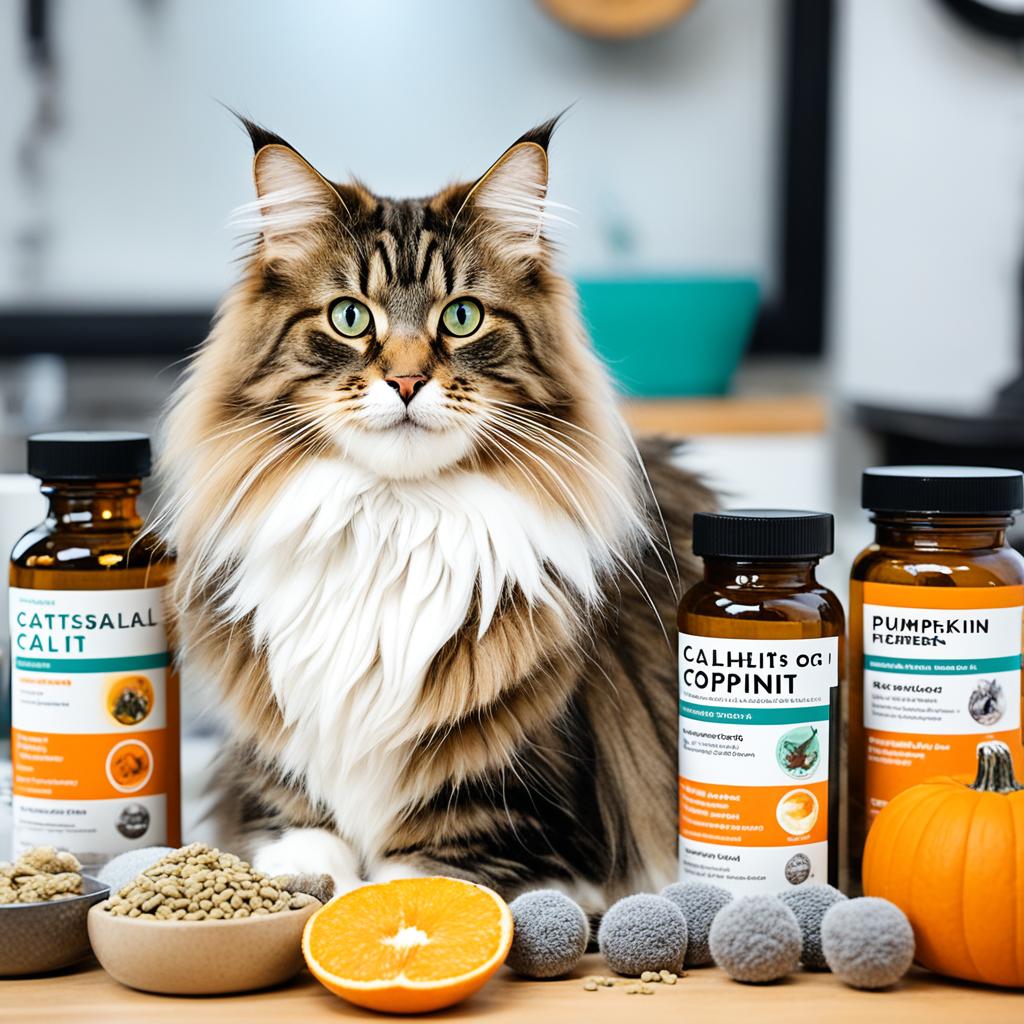
Understanding the various Norwegian Forest Cat hairball treatment options can greatly improve your feline friend’s comfort and health. Veterinary care for hairballs plays a crucial role in tackling more severe cases. Below, we delve into effective veterinary interventions and when you should seek professional assistance.
Veterinary Interventions
When it comes to dealing with severe hairballs, your vet has a plethora of tools at their disposal. These Norwegian Forest Cat hairball treatment options range from special hairball laxatives to dietary supplements designed to reduce hairball formation.
In more serious cases, radiographs or ultrasounds may be necessary to determine if a hairball is causing a blockage in the digestive system. Surgical intervention is rare but can be essential for removing obstructions that pose significant risks to your cat’s health.
When to See a Veterinarian
Knowing when to seek veterinary care for hairballs is key. If your cat frequently vomits hairballs, exhibits signs of loss of appetite, lethargy, or has difficulty defecating, it’s time to consult with a professional. Persistent issues can indicate that a larger problem is at play, warranting specialized Norwegian Forest Cat hairball treatment options.
| Symptoms | Recommended Action |
|---|---|
| Frequent Vomiting | Schedule a vet appointment for diagnostic tests and potential treatment. |
| Loss of Appetite | Consult your veterinarian to explore underlying causes and appropriate treatments. |
| Lethargy | Visit the vet to rule out severe conditions and discuss management options. |
| Difficulty Defecating | Professional veterinary care for hairballs can help alleviate blockages. |
“`
This HTML text aligns with the specified Article Structure and ensures SEO relevance without compromising the readability and context of the content.
Conclusion
Your journey into effective hairball management for your Norwegian Forest Cat doesn’t end here, but it certainly becomes smoother with the right tips and strategies. By now, you’re well-equipped to tackle those notorious hairballs through a combination of proactive grooming, thoughtful dietary adjustments, and regular veterinary check-ups. As you have learned, maintaining a consistent grooming routine can significantly reduce the frequency of hairballs, while high-fiber diets keep your feline friend’s digestive system running like a well-oiled machine.
The importance of keeping a vigilant eye on your cat’s health cannot be overstated. By addressing hairballs promptly and effectively, you not only improve their comfort but contribute to maintaining feline health overall. This isn’t just about avoiding those dreaded surprise gifts on your carpet; it’s about ensuring your Norwegian Forest Cat thrives and enjoys a full, vibrant life.
So, keep those brushes handy, monitor their diet, and never hesitate to consult your veterinarian if anything seems amiss. Your diligent care and attention mean that hairballs will be a manageable hiccup rather than a constant headache. Here’s to a cleaner home and a happier, healthier cat! Remember, the battle against hairballs is ongoing, but with the right tools and knowledge, you’re more than prepared to keep them at bay.




